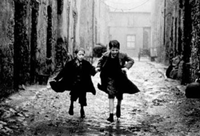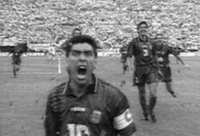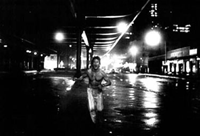
An artist spends five months making a number of young people run, showing
them how to make the T-shirts and produce digital still and motion photographs.
After some neat passing outside the box, Diego Maradona takes one step to
the left of a Greek defender and curls the ball into the top corner. He turns
and starts to run towards the camera, a white number 10 on the front of his
purple top. He keeps running, leaving teammates trailing in his wake. It's
obvious something is different about his face as he nears the lens. The
cameraman doesn't back off. Maybe some viewers do, just as they did
when the first footage of a moving train was projected.

Running backwards. Running on stilts. Running and somersaulting. It isn't
a mindless or solitary act; thinking while you run ... if I'm wearing
an A and there's an R over to my left, then if I move to the right, past
the T, then we can spell....
In eight separate locations throughout Newcastle, Gateshead and South Tyneside, one hundred
young people produce T-shirts spelling out GREAT NORTH RUN and run with them on,
creating new words as they change position. Wonder at their ease with
digital photographic equipment and wonder why they don't like running.
In 1979 Greil Marcus discusses the frequency of the word 'survive' in pop
music during the preceding decade. With the act of running, up until the
nineties there are numerous metaphorical uses - born to run, running up that
hill, band on the run, keep on running - which leave interpretation open
(running for freedom or as a challenge?). Since 1990 there have been far
fewer. No distance left to run. Always on the run. The doors are closing
a little. Do the young people that grew up in the nineties have
any wider cultural experience of the act of running?

Six still frames from the young peoples' video footage are enlarged to
48-sheet billboard format - split seconds, brief moments that work as
static images. Just picture an image of 40,000 runners wearing similar
T-shirts over thirteen miles.
Alan Dunn, October 2000